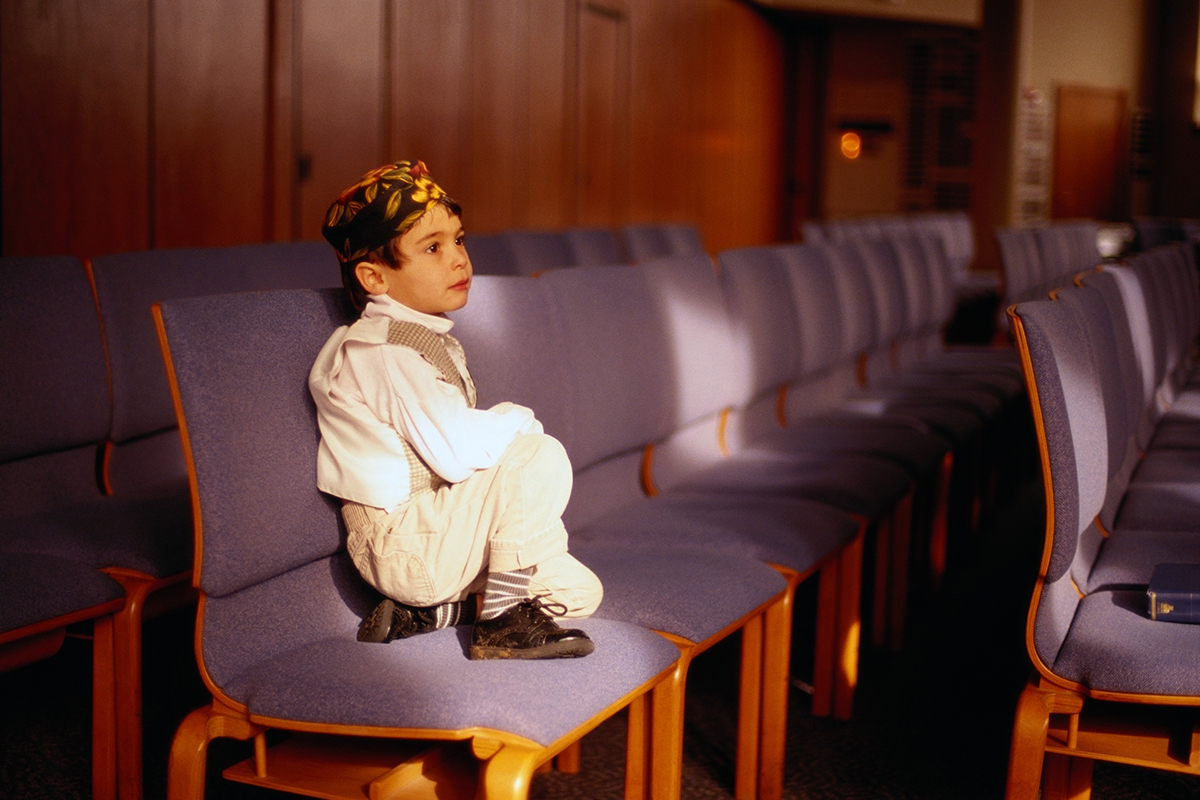My 5-year-old recently referred to the bimah, the stage of a synagogue, as the “beamer.” I chuckled — but it also got me thinking that perhaps this was a sign that it was time to get back into our weekly synagogue routine. Over the course of the pandemic, our Shabbat experiences have mainly consisted of outdoor playdates. During the first few months of the pandemic, we conducted small Shabbat services and kiddush with our stuffed animals. But after a while, even the stuffed animals got bored!
For the better part of the past 18 months, my family has been very hesitant to enter stores, restaurants or other indoor locations. While we spent most of the pandemic living at my parents’ house — which is located a few feet away from a synagogue — my sons never set foot inside during actual services. The synagogue also housed their nursery school; in-person school has been a priority for us, and their nursery school has followed strict pandemic protocols and each of our children only interacted with their designated class cohort. I worried that taking my kids to the synagogue would unnecessarily expose them to more people beyond their respective cohorts, or make others around us weary of their presence as my kids are too young to be vaccinated.
By the time Rosh Hashanah rolled around in September, however, I decided to give services a try with my family. For the High Holidays, I was scheduled to facilitate a service for families at my parents’ synagogue and I wanted my own kids to be a part of this experience. My 3-year-old was so excited to go to shul (synagogue) that he wore his brand new “Rosh Hashanah shoes” at breakfast while still in his pajamas!
To be clear, the decision to bring my kids back to synagogue was not a simple one. This was a personal decision that our family made and it is maybe not the right decision for every family to make. At the time of the High Holidays, the vaccination rates where we live were very high, and anyone eligible to be vaccinated needed to show proof of vaccination in order to enter our synagogue’s building. The synagogue has great ventilation and ample space so that families could (and did) socially distance from one another, and masks were required throughout the abbreviated service as well.
When I arrived at the synagogue with my children, the thorough Covid-19 precautions and safety measures put my mind at ease.
My kids, however, were not at ease: It was clear they didn’t really know how to “be” at shul anymore. Sure, they enjoyed seeing and waving to their friends, but they were overwhelmed by the presence of other people and not totally aware of shul-appropriate behavior for children. My kids mostly stood by my side and clung to my dress! These behaviors would have been mildly annoying under general circumstances, but it was a bit of a problem considering I was the rabbi leading the service.
I thought that my kids would just bounce back into the synagogue routine. But I was wrong: The pandemic seems to have left a few gaps in understanding how to navigate communal life. I realized that I couldn’t expect my kids to be able to naturally “read” a room. My children know what is expected of them in the classroom setting because they have had an in-person school routine for much more of the pandemic. But with the synagogue setting, I threw them right back into it!
Going forward, my husband and I decided that we will give our kids much more preparation before attending services. We now recognize the importance of socializing our kids to these experiences. Here are four tips to prepare for an outdoor or indoor synagogue experience with your family:
1. Review Covid-19 safety precautions.
Before returning to synagogue, read through the protocols for synagogue attendance. Does the synagogue require masks? Does the synagogue require proof of vaccination? Will kiddush food be served following services, and is this served indoors or outdoors? Consult with your doctor about whether it is safe for you and your family to be in a setting indoors or outdoors with other families.
Tip: Visit the synagogue during services one week without your kids to navigate the landscape. Locate areas where your kids can run around if they need a break from the main service or from a kids’ service. See if the rooms have good air circulation — even the bathrooms! If the synagogue holds a kiddush following services, observe where and how this takes place, and see whether grownups and kids keep a safe distance from one another or if there is crowding while they nosh.
Ultimately, make sure that the guidelines that are set out by the institution are adhered to in reality. If you don’t feel comfortable in the setting, it’s probably not yet a good time to bring your kids back to the synagogue setting.
2. Practice, practice, practice!
Describe what your family will encounter as you enter the synagogue setting (be it an outdoor tent, lobby or sanctuary). Role play the types of behaviors that are appropriate for that setting — including holding hands, keeping quiet voices, carrying a siddur (prayer book) and having calm bodies.
Tip: You can even “dress up” as if you’re going to shul — including putting on Shabbat shoes or a tallit — to make the role playing more fun!
3. Pack a “shul bag.”
In the Christian world, there are “mass bags” (as one website, Catholics Online, puts it: “the solution to Sunday squirmies.”) So why not have shul bags? These bags can contain small, quiet toys that have Jewish significance or toys that won’t be distracting to your child or others around you.
In our shul bags we packed a small plush Torah, a pop-it fidget toy, a kids siddur (my three-year-old likes to proudly carry the siddur from this KidKraft Shabbat set), a few quiet nut-free snacks (to eat outside only) and an extra mask. My older son likes to pack his Magnetic Shul, a toy that has magnets for all of the ritual items one would find in a synagogue setting. Quiet, reusable stickers are also a great shul bag addition. I created a “Matzah Playhouse” for Passover and I’m tempted to make one for Shabbat, given the circumstances!
Tip: Involve your child in packing their shul bag. This way, they will know what is in the bag and feel proud of their choices, just like they help in putting things in their school backpack!
4. Play appropriate tunes to get in the mood.
Prepare for the synagogue setting by listening to kids’ Shabbat playlists to familiarize your kids with the melodies they will hear in the main synagogue service or in a children’s service.
You may also hear a song in the synagogue setting and then reinforce that tune at home. Over Simchat Torah, for example, we heard a cantor sing a beautiful “Ahavat Olam” by Debbie Friedman. My preschooler has now requested to listen to it multiple times on Apple Music.
Tip: On Friday afternoons, encourage musical requests connected to your upcoming visit to the synagogue. There are endless versions of “Adon Olam” on Spotify!
Overall, it is important for us as parents to be patient with ourselves and with our children as we make the transition back into Jewish communal life and to communal life in general (and not judge others for the decisions they make!). As the pandemic created gaps in our routines, we and our kids need much more guidance as we prepare to enter different settings.
With vaccinations for younger children on the horizon, my hope is that these issues will soon fade into the past. But, in the meantime, for some of us, it might be time to start packing our shul bags!








